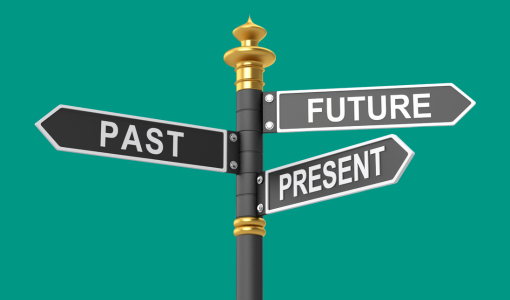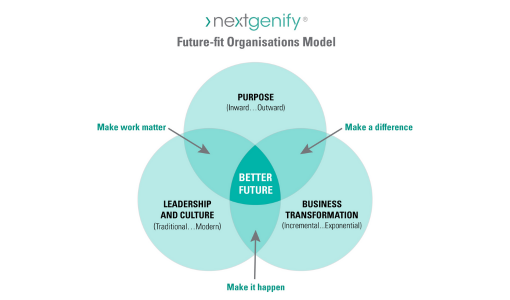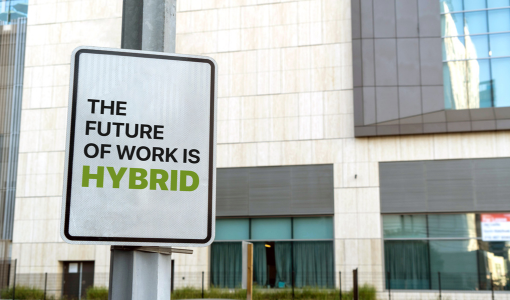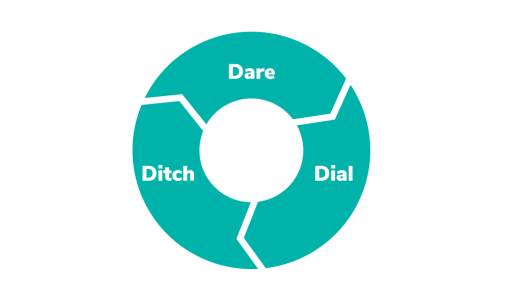Purpose-driven leadership, trust and wellbeing will define tomorrow’s organisations

01 October 2024
Five predictions for the next 10 years of work
We’re living through a market dip right now. The job market is stagnant, the cost of living keeps rising, and many workers feel stuck in their current roles, even if they’re disengaged or unfulfilled.
But this won’t last. Markets always cycle, and when the upswing comes, organisations that prioritise both their people and their impact will emerge stronger.
Yes, technology will play a critical role in the future of work. But I believe humans, not machines, will lead the trends that will elevate tomorrow’s successful workplaces.
While technology will be an increasingly formidable enabler of purpose and strategy, it’s the teams who use it wisely that will thrive. The future is human, and it needs strong leaders.
I believe five key trends will define the most successful workplaces of tomorrow.
From purpose-driven leadership to more autonomy and experimental learning, the future of work presents remarkable opportunities for leaders ready to innovate.
If you’re a leader who wants to build a thriving, resilient organisation in 2025 and beyond, keep reading.
1. Purpose-driven organisations will dominate
Let me say this loudly for the people at the back:
Purpose is not a buzzword!
Purpose is the backbone of modern business success.
But having a purpose isn’t as simple as simply posting a few motivating words onto your organisation’s website. Your purpose needs to be part of your organisational DNA, visible from inside and out.
Employees today are no longer content to simply clock in and out for a paycheque. They want to feel connected to a higher purpose, a mission that resonates with their personal values. This is particularly true for Gen Z, who now make up close to 30% of the global workforce.
The companies that succeed in the future will integrate purpose into their DNA, ensuring that every employee feels they are contributing to something bigger than themselves.

Purpose-driven leadership is becoming a core differentiator for forward-thinking organisations. Take HESTA, an Australian industry super fund, as an example. Their mission is clear:
We invest in and for people who make our world better.
By aligning their investment strategy with the values of their members, HESTA showcases how purpose can guide decisions that benefit both people and the planet.
On the other end of the spectrum, companies that cling to command-and-control leadership models are pushing employees back into the office, prioritising control and status over flexibility and trust. This outdated approach, sometimes driven by short-term financial gains, will ultimately alienate talent and stagnate innovation.
And purpose matters to customers just as much as it does to employees.
In today’s market, customers are increasingly drawn to companies with a clear, compelling mission. Organisations that communicate their purpose effectively will win over competitors by building trust and loyalty, making purpose not just a differentiator but a driver of long-term success.
Leaders who embrace purpose-driven models will not only attract top talent but also retain and engage them, creating environments where innovation and collaboration thrive.
2. Trust is the cornerstone of future work models
Trust is the single most important factor that separates thriving organisations from those stuck in outdated models.
Many leaders pushing for a full-time return to the office aren’t motivated by collaboration or culture but by a lack of power, status and trust.
But as Carol Folt, President of the University of Southern California aptly puts it:
Trust is hard-earned, easily lost, and difficult to reestablish.
Forcing employees back into the office risks undermining that trust, which, once broken, can be nearly impossible to regain.
Companies like Spotify and Atlassian understand that trust isn’t built through surveillance but through autonomy and flexibility. By embracing 'work from anywhere' policies, they show that trust is about outcomes, not physical presence.
Trust enables teams to function with autonomy, creativity and speed. And trust is a two-way street. When employees feel trusted, they’re more likely to take ownership of their work, solve problems creatively and collaborate meaningfully.
On the flip side, when employees are monitored and micromanaged, it stifles innovation and drives disengagement.
When I hear of people using mouse jigglers to trick bosses into thinking they’re working, I’m confident they’re stuck in environments where trust has eroded.
Organisations that build trust over surveillance will retain talent and boost innovation.
The leaders of the future are those who can let go of outdated power dynamics, empowering teams to operate with trust and flexibility. Trust is a competitive advantage, and organisations that prioritise it will be the ones to thrive.

3. Hybrid work is here to stay
Hybrid work is no longer a temporary solution; it’s become the default.
While remote work offers flexibility, there’s no denying the value of in-person collaboration for building relationships, fostering innovation and maintaining company culture.
The challenge for leaders is to refine their hybrid models, balancing the need for deep work and collaboration without sacrificing flexibility.
Australian financial service company Insignia Financial has made hybrid work a key pillar of its commitment to gender equality. Their hybrid policy allows employees to work up to 60% of their time remotely, recognising that flexibility is a critical enabler for women, who are often disproportionately impacted by rigid return-to-office mandates.
Similarly, global companies like Microsoft have demonstrated how hybrid models enhance productivity and employee satisfaction. Their flexible work policy allows teams to collaborate in person while enjoying remote work’s focus and flexibility.
However, hybrid work isn’t just about allowing people to work from home. It’s about designing workspaces and cultures that foster meaningful connections without compromising the flow of work.
Leaders who can strike the right balance between in-person and remote work will unlock the full potential of their teams, benefiting from both flexibility and collaboration.
Enabling flexibility has obvious benefits for employees, but it’s not a zero-sum game. It can also lead to positive outcomes for customers and ultimately bolster the bottom line. Achieving this win-win isn’t a given—it requires a proactive and deliberate approach that embraces entirely new ways of thinking.
The opportunity in front of leaders today is a big one, and if done right can help them find the balance between business outcomes and employee growth and wellbeing.
- Jared Spataro, Corporate Vice President of Modern Work, Microsoft
.png)
4. Employee wellbeing as a strategic priority
Mental health and wellbeing are becoming strategic priorities for organisations that want to retain talent and increase productivity.
Employee burnout is an ongoing issue exacerbated by the pandemic and the increasing pressure to perform in high-stakes environments. Companies that fail to address these issues risk losing their most valuable assets – their talented people.
Forward-thinking organisations are investing in comprehensive wellbeing programs that go beyond surface-level benefits.
Head of the Mental Wealth Initiative, Associate Professor Jo-An Occhipiniti, reframes this as investing in ‘mental wealth’ - the collective cognitive and emotional resources of individuals. She describes mental wealth as essential for community resilience and economic prosperity.
This mindset challenges organisations to move basic wellness offerings and adopt a holistic, future-focused approach to employee wellbeing.
There needs to be more than a box of fruit in the kitchen.
Flexible hours, access to mental health resources, and creating a culture of empathy are essential. But there’s another crucial piece: psychological safety.
Psychological safety means employees feel empowered to speak up, share ideas and take risks without fear of punishment or judgment. When combined with wellbeing initiatives, it creates a resilient workforce capable of navigating the complexities of modern work and achieving extraordinary outcomes.
For leaders, this means going beyond compliance. It means fostering an environment where people feel truly safe to be bold, courageous or simply be themselves.
Leaders who prioritise psychological safety can unlock extraordinary results. When people are free to challenge the status quo and take calculated risks, teams push boundaries, solve complex problems and drive the business forward. Psychological safety is a strategic advantage that sets high-performing organisations apart.
5. Autonomy and experimental learning will accelerate
The traditional career ladder will be replaced by a more fluid approach where autonomy and experimental learning drive performance and innovation.
Autonomy is key to how people do their best work. As Dan Pink puts it:
Human beings have an innate inner drive to be autonomous, self-determined, and connected to one another. And when that drive is liberated, people achieve more and live richer lives.
And it’s already happening.
Buurtzorg, a healthcare organisation in the Netherlands, empower nurses to make decisions through self-managing teams. This decentralised approach enhances autonomy, resulting in higher levels of engagement and patient care, as well as opportunities for internal mobility.
All of Buurtzorg innovations come from one person or a team having an idea and the freedom to try something new.
For example, Buurtzorg has an annual national walker race after one team and their clients organised a neighbourhood walker race. The idea has now spread across the community of 10,000 nurses.
Another great example of autonomy in action is Haier, the Chinese multinational home appliances and consumer electronics company. Their management model transformed the company into a network of micro-enterprises, where each employee acts as an entrepreneur, directly connected to customer needs.
As Zhang Ruimin, Haier's CEO, explained:
We replaced the bureaucratic model with a model based on self-employment, self-motivation, and self-organisation. Our goal is to let everyone become their own CEO.
Experiential learning is another game-changer. Rather than relying on traditional training programs, which often result in a minimal return on investment beyond shallow satisfaction surveys, experiential learning offers a higher impact. People learn by doing and working on real initiatives that develop their skills in real-time.
A standout example of the power of experimental learning is the ExO Sprint, a three-month, intensive innovation bootcamp.
In an ExO Sprint, I coach teams through an immersive experience, developing impactful solutions to large, juicy problems. This kind of hands-on learning not only drives innovation but also accelerates personal and professional growth.
 The future of work is 3D: Dare, ditch, dial
The future of work is 3D: Dare, ditch, dial
The future of work and leadership is all about what I call ‘Working in 3D’.
Leaders must dare to be bold, ditch outdated practices and dial-up new ways of working rooted in trust, autonomy and flexibility.
Purpose-driven, trust-based organisations that prioritise employee wellbeing are the ones that will succeed in the coming years. By embracing these trends, leaders can build resilient, adaptable teams capable of thriving in an unpredictable world.
Work in 3D is the future. And leaders can start daring, ditching and dialling in better ways of working starting today.
Take the next step toward transformative leadership
As the future of work evolves, so must your approach to leadership. If you're ready to lead with purpose, build trust, and create lasting change in your organisation, now is the time to act.
My tailored leadership coaching can help you unlock your potential, empower your team, and thrive in the ever-changing work environment. Start your journey to becoming the leader you’ve always aspired to be.
Book a discovery call with me today and take the first step towards transformative leadership.
Enter your email address and name to subscribe to our blog and receive notifications of new posts by email.
